#Archduke Ludwig Viktor of Austria
Text
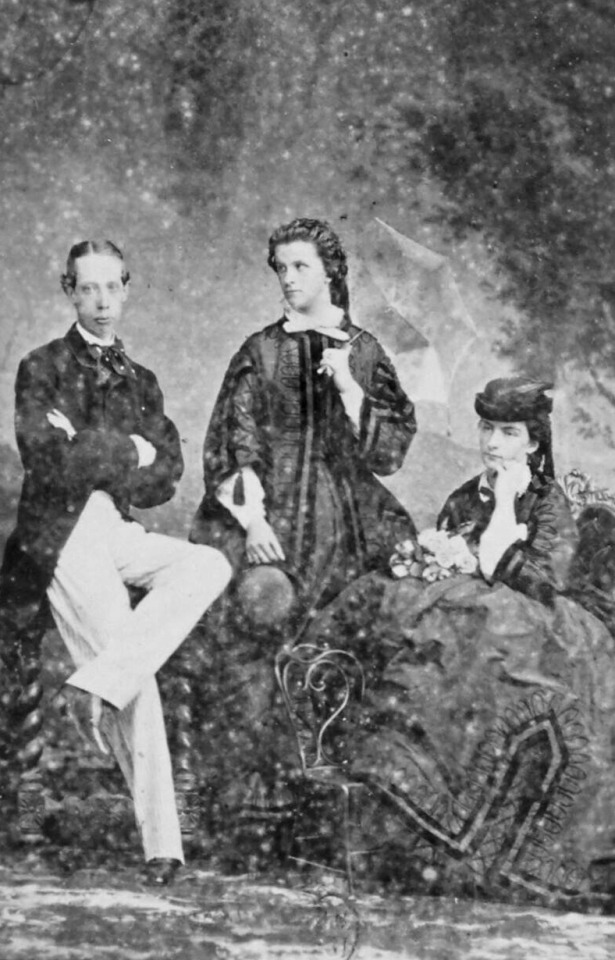
Archduke Ludwig Viktor of Austria with his cousins Mathilde, Countess of Trani and Queen Marie Sophie of the Two Sicilies (née Duchesses in Bavaria). Circa mid 1860s.
Via Gallica
#this pic has a lot of ''you can't sit with us'' energy#archduke ludwig viktor of austria#mathilde in bavaria countess of trani#queen marie sophie of the two sicilies#house of habsburg#house of wittelsbach
18 notes
·
View notes
Text
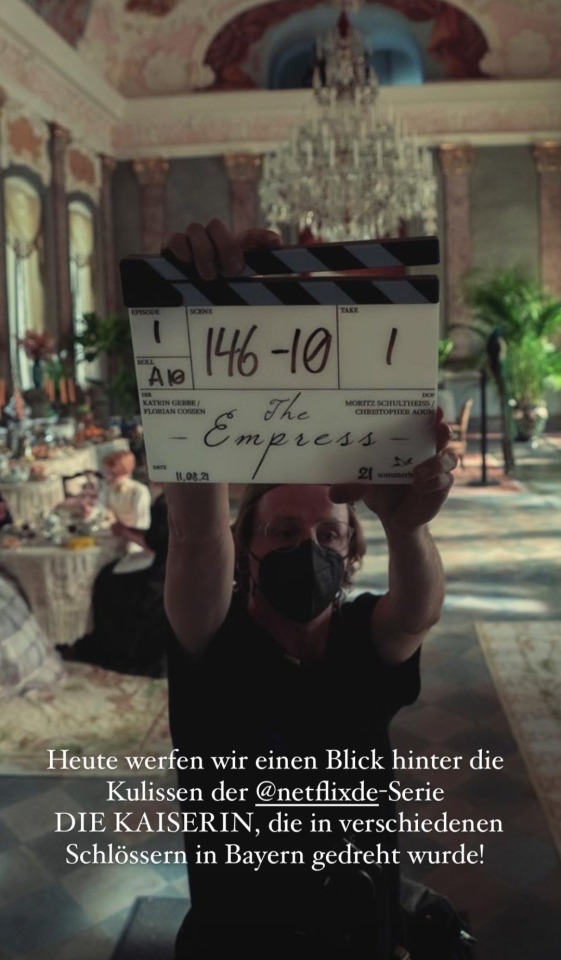





The German Film Commission shared some behind the scenes pictures from The Empress (2022) on instagram.
#the empress#the empress (2022)#die kaiserin#costume drama#historical drama#period drama#melika foroutan#devrim lingnau#irene della casa#johannes nussbaum#Felix Nölle#archduchess sophie of austria#princess sophie of bavaria#elisabeth in bavaria#elisabeth of austria hungary#elisabeth of austria#archduke maximilian#maximilian of mexico#baroness francesca#archduke ludwig viktor#german series#german tv#behind the scenes#netflix
8 notes
·
View notes
Photo
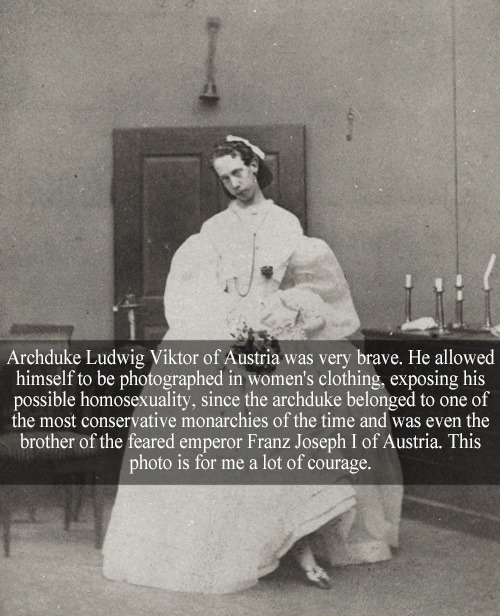
“Archduke Ludwig Viktor of Austria was very brave. He allowed himself to be photographed in women's clothing, exposing his possible homosexuality, since the archduke belonged to one of the most conservative monarchies of the time and was even the brother of the feared emperor Franz Joseph I of Austria. This photo is for me a lot of courage.” - Text & Image Submitted by cenacevedo15
41 notes
·
View notes
Photo
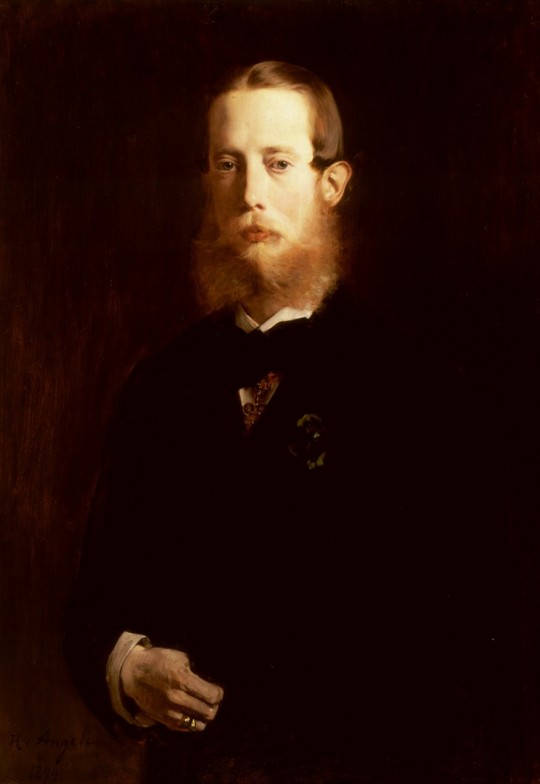
Archduke Ludwig Viktor of Austria (1842-1919), younger brother of Emperor Franz Joseph I of Austria and Emperor Maximilian I of Mexico. Unknown artist.
#house of habsburg lorraine#erzherzog#kaisertum österreich#archduke#erzherzog ludwig viktor von österreich#bubby
14 notes
·
View notes
Note
I agree with you on the ask but I don't understand your supporting examples
Of Queers and Tattoos?
I could go on and on about how the use of the word, "traditional," in that ask was deeply problematic and ignorant. Queer people and tattoos have always existed, just because they're not permitted by "traditional" Christian belief systems does not mean that their existence has been erased or forgotten.
The photos I used were of Fredrick IX of Denmark and Tsar Nicholas II of Russia (the one who got overthrown); allegedly George V was tattooed by the same guy as Freddy Boy, but I could not find photo evidence.
Currently, I know Crown Prince Fredrik (of Denmark) has a tattoo on his thigh, Princess Eugenie (of York) has one behind her ear, and Princess Sofia (of Sweden) has one on her back.
As for the LGBT nobility and royalty link, I urge you to click a few names on the lists and read their wiki. Queer history needs to be remembered, preserved, told, and protected, now more than ever. My personal favorite Queer Royal Historical Figures are:
Christina of Sweden - Queer icon of her time, her life and rule is just fascinating.
James VI and I - Son of Mary, Queen of Scots. I am a true supporter of Jacobite succession, they were ROBBED. Any descendent of Mary is and Icon, and he certainly came and served.
Archduke Ludwig Viktor of Austria - If you've watched "Die Kaiserin" on Netflix, he's the little boy! He was the openly gay little brother of Emperors Maximilian I of Mexico and Franz Joseph I of Austria (husband of Sissi)
6 notes
·
View notes
Photo

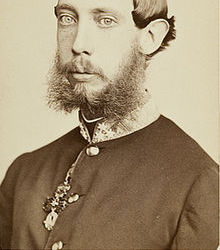
Archduke Ludwig Viktor of Austria (deceased)
Gender: Male
Sexuality: Gay
DOB: 15 May 1842
RIP: 18 January 1919
Ethnicity: White - Austrian
Occupation: Nobility, soldier, art collector, drag artist (kinda)
#Ludwig Viktor of Austria#Archduke Ludwig Viktor of Austria#lgbt history#lgbtq#lgbt people#male#gay#1842#rip#historical#white#austrian#nobility#soldier#art collector#drag artist
94 notes
·
View notes
Text

Photography of Archduchess Sophie of Bavaria with her youngest son Ludwig Viktor (second from right) and other unknown persons by Hermann Norden, 1865.
#royality#austria#habsburg#wittelsbach#archduchess of austria#sophie of bavaria#archduke ludwig viktor of austria
2 notes
·
View notes
Photo

Maria Theresa of Austria-Este was the last Queen of Bavaria. She was the only child of Archduke Ferdinand Karl Viktor of Austria-Este and Archduchess Elisabeth Franziska of Austria. She married Prince Ludwig, eldest son of Bavaria's Prince Regent Luitpold, who became Louis III King of Bavaria.
8 notes
·
View notes
Text
King Pedro V’s 5th sibling: Infanta Maria Ana de Portugal

Born: 21st August 1843 Necessidades Palace, Lisbon, Portugal
Died: 5th February 1884 (aged 40) Dresden, Saxony
Infanta Maria Ana of Portugal (Maria Ana Fernanda Leopoldina Micaela Rafaela Gabriela Carlota Antónia Júlia Vitória Praxedes Francisca de Assis Gonzaga) (21st August 1843 – 5th February 1884) was a Portuguese infanta (princess), the eldest surviving daughter of Queen Maria II of Portugal and her King consort Fernando II of Portugal, a member of the House of Bragança.
After her mother's death in 1853, when Maria Ana was just ten years old, she became the leading lady of the court, until her older brother, King Pedro V of Portugal, married Princess Stephanie of Hohenzollern-Sigmaringen,

in 1858. Although in the early stages of their acquaintance the two sisters-in-law had a good relationship, in a letter written in 1859 to Prince Albert of Saxe-Coburg and Gotha,

when Stephanie was already dead, King Pedro mentions that his sister made unflattering comments regarding his wife "because of her feminine vanity caused by a lower status (...)"
The relationship between the sisters-in-law seems to have had its ups and downs since Stephanie's arrival in May 1858 and Maria Ana's wedding in May 1859. The Queen wrote about her sister-in-law: "She is, in every respect, the one who is more like Pedro (...)", "She is a charming person, good, generous, remarkably sensible for her age, with no trace of selfishness, respected and loved by all of us (...) George of Saxony has discovered a true gem. She is happy and loves him, but she cannot talk about the moment in which she will leave her family without crying. What is certain is that she will leave a terrible emptiness behind". Maria Ana's brother, Pedro, also claims during this time that his sister is "the pearl of our family circle", in a letter to Prince Albert.
She married in Lisbon at the Belém Palace on 11th May 1859 Prince George of Saxony (1832–1904),

second son of King John I of Saxony,

a kinsman from the Catholic Albertine branch of her father's Wettin dynasty. Queen Stephanie tried to organize a brilliant ceremony, but, in the end, the wedding was quiet and went unnoticed in both Portugal and Saxony. The newly-weds spent their first days as a married couple at Belém Palace. During their short stay in Portugal after the ceremony, Prince George left a poor impression with the Portuguese Royal Family, as he "barely talked to the bride" and did not attend a theater performance to which he had been invited. During that same performance, 15-year-old Maria Ana was seen crying. The couple left to Saxony on May 14th. Maria Ana was not allowed to take Portuguese ladies-in-waiting with her and was only accompanied by her brother Luís
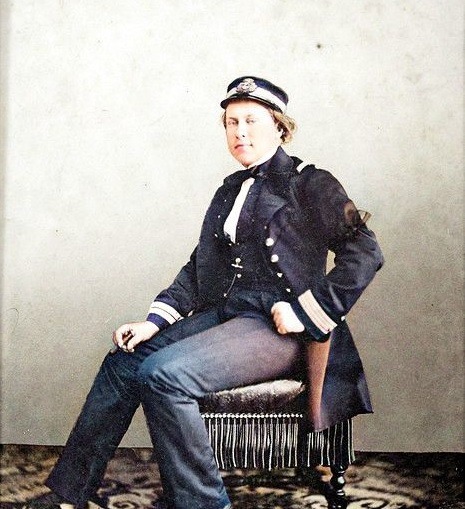
in the journey. Pedro V wrote the following regarding the wedding: "the wedding of my sister to Prince George of Saxony was celebrated with more pomp than happiness. The former is followed by a regretful fate, as he left no sympathies and people who met him often left with a poor impression."
The marriage was not a happy one, according to Historian Eduardo Nobre who claims that the Prince "did not live up to the expectations and qualities of the Portuguese Infanta". Despite their issues, they had eight children.
Although she renounced her claims to the Portuguese throne when she married, Maria Ana could still become Queen if the male line became extinct. This situation nearly happened in 1861, when King Pedro V and two of her other brothers died from Typhoid Fever and left no children. However, this hypothesis was completely put aside when her brother, King Luís I, married Princess Maria Pia of Savoy
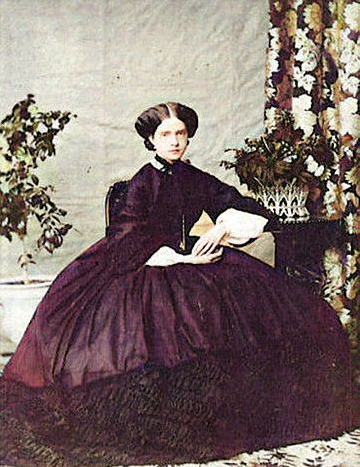
and had two sons, the future King Carlos I

and Infante Afonso.
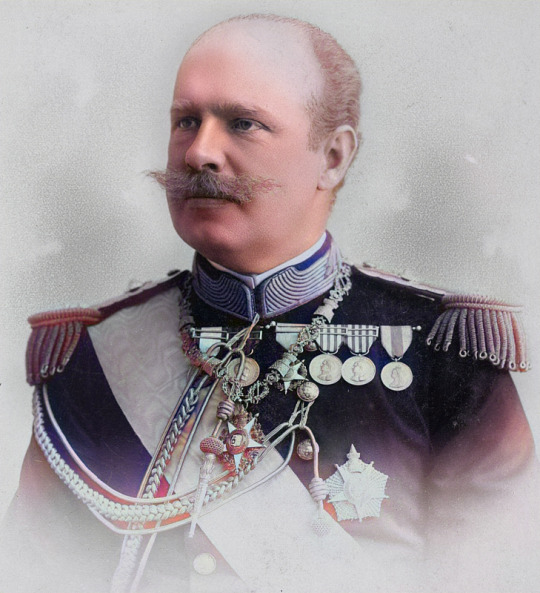
Despite everything, it's not likely that Maria Ana ever gave this hypothesis great importance because of her troubled marriage and many children.
Around 1883, her youngest son, Prince Albert of Saxony,

became seriously ill. Maria Ana took care of him for several months until he recovered. This effort would be fatal, as the Infanta died from exhaustion, on 5th February 1884, before her husband became King. Her husband would remain unmarried for the rest of his life.
In Portugal, her second brother Luís I soon succeeded her eldest brother Peter V as king.
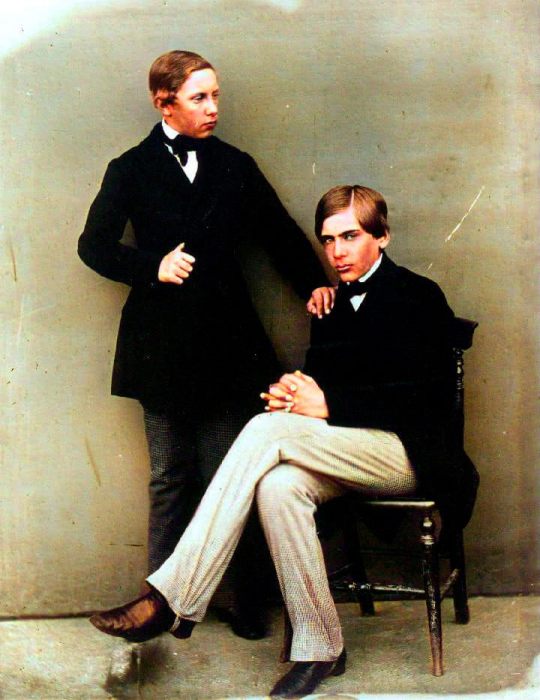
Her husband's elder brother Albert

succeeded her father-in-law as King of Saxony and gradually it became clear that he and his wife Carola of Vasa

were not able to have children of their own. Maria Ana's eldest son would almost certain to one day succeed to the throne.
Marie Johanna Amalie Ferdinande Antonie Luise Juliane, (19th June 1860 - 2nd March 1861), died in childhood, no issue
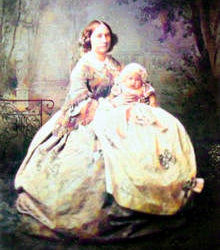
Elisabeth Albertine Karoline Sidonie Ferdinande Leopoldine Antonie Auguste Clementine (14th February 1862 - 18th May 1863) died in childhood, no issue
Mathilde Marie Auguste Viktorie Leopoldine Karoline Luise Franziska Josepha (19th March 1863 - 27th March 1933) died unmarried, no issue
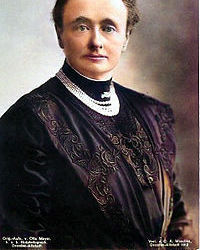
Frederick Augustus Johann Ludwig Karl Gustav Gregor Philipp (25th May 1865 - 18th February 1932)

married Princess Louise of Tuscany (1870–1947),
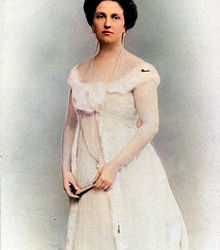
later divorced, had issue
Maria Josepha Luise Philippine Elisabeth Pia Angelica Margarethe (31st May 1867 - 28th May 1944)

married to her cousin second degrees Archduke Otto Franz of Austria (1865–1906),
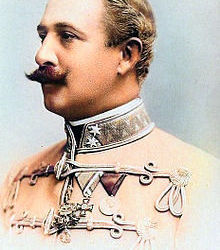
had issue
Johann Georg Pius Karl Leopold Maria Januarius Anacletus (10th July 1869 - 24th November 1938) married first Duchess Maria Isabella of Württemberg (1871–1904) and second Princess Maria Immaculata of Bourbon-Two Sicilies (1874–1906)

Maximilian Wilhelm August Albert Karl Gregor Odo (17th November 1870 - 12th January 1951) ordained as a priest, died unmarried, no issue
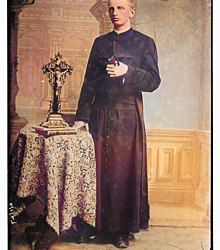
Albert Karl Anton Ludwig Wilhelm Viktor (25th February 1875 - 16 September 1900) died unmarried, no issue.

Princess Maria Ana predeceased her father Fernando, her husband George, and her brother-in-law King Albert of Saxony. In 1902 George succeeded his childless brother as king, and on his death in 1904 Maria Ana's eldest son became King of Saxony as Frederick Augustus III.
#infanta maria ana de bragança#house of bragança#queen maria ii of portugal#king consort fernando ii#king pedro v of portugal
11 notes
·
View notes
Text

At eight o'clock on the morning of Saturday, 9 April, the Imperial train with Franz Josef on board drew up at the private station at Miramar, where Maximilian was waiting to receive him. The Emperor was accompanied by an impressive retinue: seven Archdukes, including his two brothers, Karl Ludwig and Ludwig Viktor; three ministers, one of them Count Rechberg; the Chancellors of Hungary, Croatia and Transylvania; the Chief of the General Staff and the civil and military governors of Venetia and of Istria, accompanied by a bevy of secretaries and aides-de-camp. But not even Count Rechberg was witness to the private conversation between the two brothers, which lasted for nearly two hours. Officers of the Themis and the Novara, anchored off Miramar, assert that at one time during the interview they saw the Archduke come out on to the terrace and pace up and down in an obvious state of agitation, till he was recalled by one of the Emperor's aides-de-camp. It was past eleven when the two brothers returned to the state apartments to put the final signature to the "Family Pact", witnessed by the highest dignitaries of the Empire. And though Maximilian was later to declare that he had been forced to sign under duress, it was noted at the time that not only the Archduke but also the Emperor had reddened eyes, as if he regretted what he had been forced to do.
The "pact" was signed. The naval band playing ouftide the castle struck up "Gott Erhalte Unser Kaiser" and Charlotte, her radiant composure in striking contrast to that of her husband and brother-in-law, came forward to take the Emperor's arm and lead him into the state banqueting hall. At half past one, Franz Josef was already at the station. The farewells had been formal and correct. But at the moment of boarding the train, he appears to have felt a twinge of tenderness and regret. All the dissensions of the last years, all the bitterness and suspicions were forgotten. He knew only that he was parting, perhaps for ever, from a once-beloved brother. In a voice broken with emotion, he called out, "Maxl", holding out his arms to embrace him for the last time. Ministers and generals looked away, for both the brothers were in tears.
Haslip, Joan (1971). The Crown of Mexico: Maximilian and his Empress Carlota
ON THIS DAY, IN 1864, ARCHDUKE FERDINAND MAXIMILIAN OF AUSTRIA RENOUNCED TO HIS HEREDITARY RIGHTS IN ORDER TO BECOME EMPEROR OF MEXICO. Archduke Maximilian was the second son of Archduke Franz Karl of Austria and his wife Princess Sophie of Bavaria, and therefore, a younger brother of Emperor Franz Josef I of Austria. Maximilian had been offered the crown of Mexico, at that time under French intervention, assured that the people had voted in favor of establishing a monarchy. Renouncing to his Habsburg rights was the condition that his brother Franz Josef put forward if he accepted the Mexican offer, which he did. When Maximilian signed the deal, he was second in the line of succesion to the throne of the Austrian Empire.
#the date fell on a saturay again!#maximilian i of mexico#franz josef i of austria#house of habsburg#historian: joan haslip#the crown of mexico: maximilian and his empress carlota (1972)#on this day in history
20 notes
·
View notes
Text
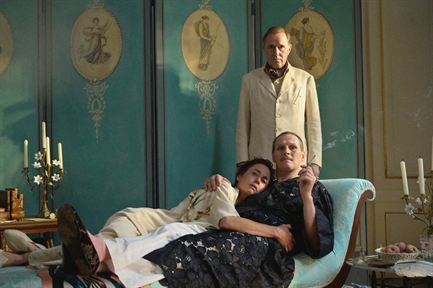
Susanne Wolff, Stefan Kurt and Georg Friedrich as Empress Elisabeth, Count Berzeviczy and Archduke Ludwig Viktor in Sisi & Ich (2023).
#Sisi und Ich#Sisi and I#costume drama#historical drama#period drama#Susanne Wolff#Stefan Kurt#Georg Friedrich#elisabeth of austria hungary#elisabeth of austria#elisabeth in bavaria#Count Berzeviczy#Archduke Ludwig Viktor#german movie#german tv
4 notes
·
View notes
Text
The Story Of The Napoleon Diamond Necklace
New Post has been published on https://www.inspiredbycreativityjewels.co.uk/the-story-of-the-napoleon-diamond-necklace/
The Story Of The Napoleon Diamond Necklace


Image by/from Cliff from Arlington, VA (Outside Washington DC), USA
The Napoleon Diamond Necklace is a diamond necklace commissioned by Napoleon I of France c. 1811-1812. It is currently on display in the Smithsonian Institution in Washington, D.C., United States.
The Napoleon Diamond Necklace consists of 28 mine cut diamonds set into a single thread, with a fringe of alternating pendeloque and briolettes diamond cuts. The five pear-shaped pendoloques are each mounted below a small brilliant cut diamond. The four ovaline pendeloques are mounted above designs which incorporate 23 brilliant cut diamonds each. Each briolette mounting is set with 12 rose cut diamonds.
While the gems of the Napoleon Diamond Necklace have never been professionally graded by a lapidary (as they have never been removed from their mountings), infrared spectroscopic analysis of the diamonds has shown that they are primarily Type Ia. However, 13 of the 52 largest diamonds in the necklace are of the rare Type IIa variety. A number of the Type Ia diamonds show indications of sulfide crystal imperfections.
In 1810, Napoleon I of France divorced the Empress Josephine, as she proved to be incapable of producing an heir. He re-married two months later to Archduchess Marie Louise of Austria. Within a year, Marie Louise bore a son. To celebrate, in June 1811 Napoleon I commissioned the Napoleon Diamond Necklace from the Parisian jewellery firm Nitot et Fils, at a cost of 376,274 French francs. This sum was the equivalent of the Empress’s entire annual household budget. There are several contemporary portraits of Marie Louise wearing the Napoleon Diamond Necklace, including a number by the artists Francois Gerard and Giovan Battista Borghesi. Several years later, in 1815, Napoleon was exiled to Saint Helena. Marie Louise returned to Austria with the necklace and owned it until her death.
Upon the death of Marie Louise in 1847, the necklace passed to Archduchess Sophie of Austria, the wife of her brother Archduke Franz Karl of Austria. Two diamonds were removed from the necklace to shorten it, at the request of Princess Sophie. These diamonds were fitted to a pair of earrings, the location of which is now unknown. Following the death of Sophie in 1872, the Napoleon Diamond Necklace was jointly inherited by her three surviving sons, Archdukes Karl Ludwig, Ludwig Viktor, and Franz Joseph of Austria. Karl Ludwig later acquired his brothers’ stakes in the necklace, and upon his death in 1914 passed it to his third wife, Maria Theresa of Portugal.
At the start of the Great Depression in 1929, Maria Theresa engaged two people presenting themselves as “Colonel Townsend” and “Princess Baronti” to sell the necklace for US$450,000. Realising that the current economic conditions would make it almost impossible to reach the asking price, the pair began offers at $100,000, signing on Archduke Leopold of Habsburg, the destitute grandnephew of Maria Theresa, to vouch for the necklace’s authenticity. Deals were negotiated with the jewelers Harry Winston and Harry Berenson, but eventually the pair sold the necklace to David Michel of New York City for $60,000, of which the pair claimed $53,730 as expenses. When informed of the sale, Maria Theresa took the matter to court, eventually resulting in the recovery of the necklace, the jailing of Archduke Leopold, and the flight of Townsend and Baronti from the authorities.
After resolving the incident, Maria Theresa held the necklace until her death in 1944. Four years later, the Habsburg family sold it to the French industrialist Paul-Louis Weiller. In 1960, Weiller sold the Napoleon Diamond Necklace to Harry Winston, who believed that the historical value of the piece would make it more valuable than if the stones were removed and resold individually, as was common practice at the time. As such, he kept it intact, reselling it the same year to Marjorie Merriweather Post. Post donated the necklace to the Smithsonian Institution in 1962, and it has since remained on display at the National Museum of Natural History in Washington, D.C., United States.
2 notes
·
View notes
Photo
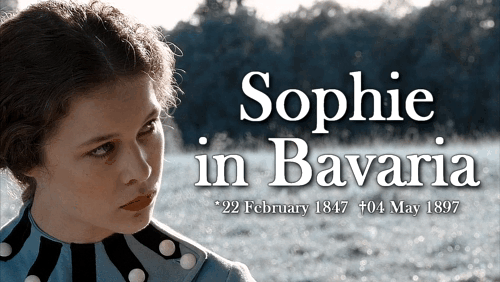

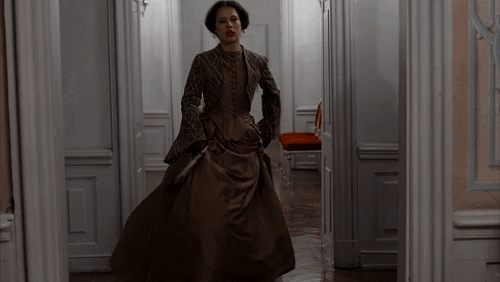
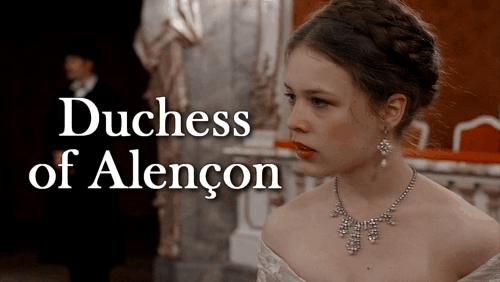
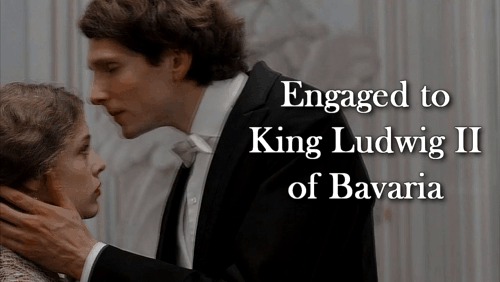



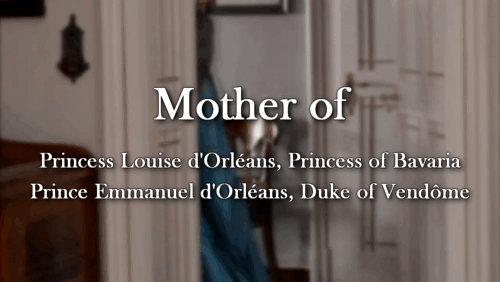

House of Wittelsbach & of Bourbon: : Sophie in Bavaria
Sophie was born as the ninth of ten children of Duke Maximilian in Bavaria and his wife Princess Ludovika of Bavaria. She is the younger sister of Helene in Bavaria, Hereditary Princess of Thurn and Taxis, Empress Elisabeth of Austria, Queen Marie of the Two Sicilies and Mathilde in Bavaria, Countess of Trani.
As the sister-in-law of the Austrian emperor, many noble men asked for or considered her hand in marriage. The most famous contenders were Archduke Ludwig Viktor of Austria - younger brother of the Austrian emperor -, the future King Luís I of Portugal and Duke Philipp of Württemberg.
She shared a passion for nature and the music of Richard Wagner with her two years older cousin King Ludwig II of Bavaria. They became engaged in 1867 but Ludwig broke it off in October the same year as rumors were spreading that Sophie was actually in love with court photographer Edgar Hanfstaengl.
After the broken engagement, she became severely depressed. Because of that she was sent to stay with her aunt Queen Amalie Auguste of Saxony. It was in Saxony, Sophie met Prince Ferdinand of Orléans, Duke of Alençon. He was the son of Prince Louis, Duke of Nemours and grandson of the late King Louis Philippe of the French. Soon after, on September 28th, 1868, she married him at her childhood home in Possenhofen Castle. They had two children: Louise and Emmanuel.
Like many of her relatives, Sophie, too, suffered from mental health issues. In 1886, she was admitted to a psychiatric hospital. In the same winter, she supposedly fell in love with her doctor. It is said they wanted to run away together and Sophie wanted to divorce her husband. This in the end came not into being, as Sophie was diagnosed with “moral insanity” and her husband placed her in the sanatorium in Mariagrün.
Sophie died in a fire at the Bazar de la Charité in Paris on May 4th, 1897. She had refused rescue attempts, insisting that the girls working with her at the bazaar be saved first. Attempts to have her body identified by her personal maid having failed, her dentist was called in. After two hours examining various bodies he identified hers on the basis of her gold fillings.
// Cast: Paula Beer as Sophie in Bavaria in Ludwig II. (2012)
#women in history#perioddramaedit#Sophie in Bavaria#historic women#19th century#House of Wittelsbach#Royal Women of Bavaria#Movie: Ludwig II. (2012)#Ludwig II (2012)#Ludwig II of Bavaria#period drama#House of Orléans#House of Bourbon
187 notes
·
View notes
Text
Archduke Ludwig Viktor of Austria
Archduke Ludwig Viktor of Austria
Archduke Ludwig Viktor Joseph Anton of Austria (15 May 1842 – 18 January 1919) from the House of Habsburg was the youngest son born to Archduke Franz Karl of Austria and Princess Sophie of Bavaria and younger brother of Emperor Franz Joseph I of Austria.
He was born in Vienna shortly after his sister Archduchess Maria Anna had died at four years of age, followed by a stillborn brother. His elder…
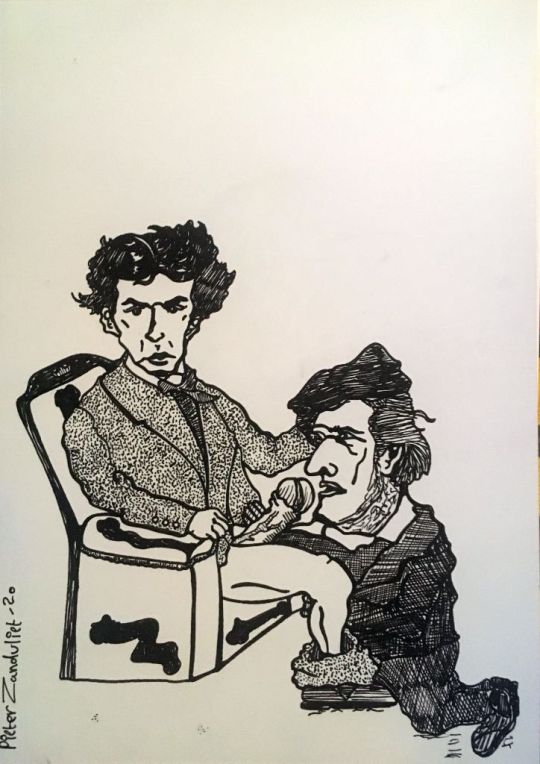
View On WordPress
0 notes
Photo
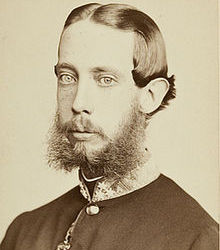
LGTBQA Royals
Archduke Ludwig Viktor of Austria
Ludwig Viktor’s homosexuality was an open secret. Even his brother Franz Josef joked about it. But in 1906, at the age of 64, the archduke was slapped and knocked to the ground by one of the young Centralbad patrons, an athletic middle-class man, apparently as the result of an unwanted advance by the archduke.
Ludwig Viktor used his family ties to have the young man arrested, but it was determined that the man’s actions were warranted, and he was released from jail.
When informed of his brother’s scandalous behavior, Emperor Franz Joseph became extremely angry and banished Ludwig Viktor to the archduke’s summer palace, Schloss Kleßheim, a former residence of the Archbishops of Salzburg, and ordered him not to return to Vienna during his brother's lifetime. Ludwig Viktor was also forced to resign his patronages, and most of his staff was moved to other positions.
*Some of these are more rumour that fact so please take with a grain of salt and with the story given.*
6 notes
·
View notes
Photo
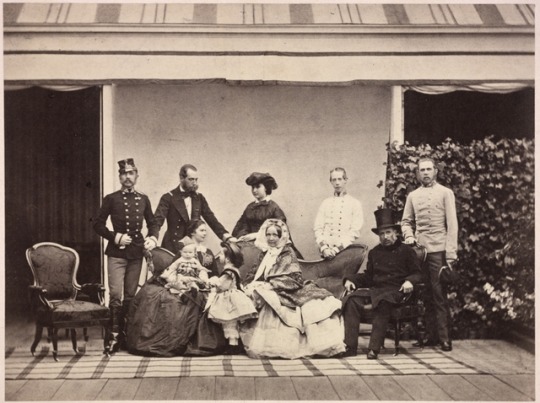
The imperial family of Austria (Emperor Franz Joseph, Archduke Maximilian [later Emperor of Mexico], Archduchess Charlotte, Archduke Ludwig Viktor**, Archduke Karl Ludwig; Empress Elisabeth aka Sisi with Crown Prince Rudolf, Archduchess Gisela, Archduchess Sophie***, Archduke Franz Karl) by Ludwig Angerer, 1859
*see also:
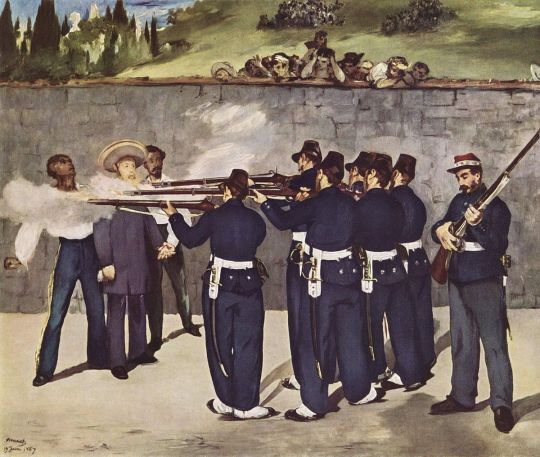
**sidenote: “A főherceg szeretett nyilvánosan női ruhákban megjelenni, az ebből származó botrányos eseteket – a szigorú sajtócenzúra ellenére – egyre kevésbé lehetett leplezni. Amikor azonban a bécsi Weihburggassén lévő Zentralbad közfürdőben (ma Kaiserbründl néven a homoszexuálisok szaunája) nyilvánosan és félreérthetetlenül közeledett más férfiakhoz, az esetet nem lehetett többé eltussolni.”
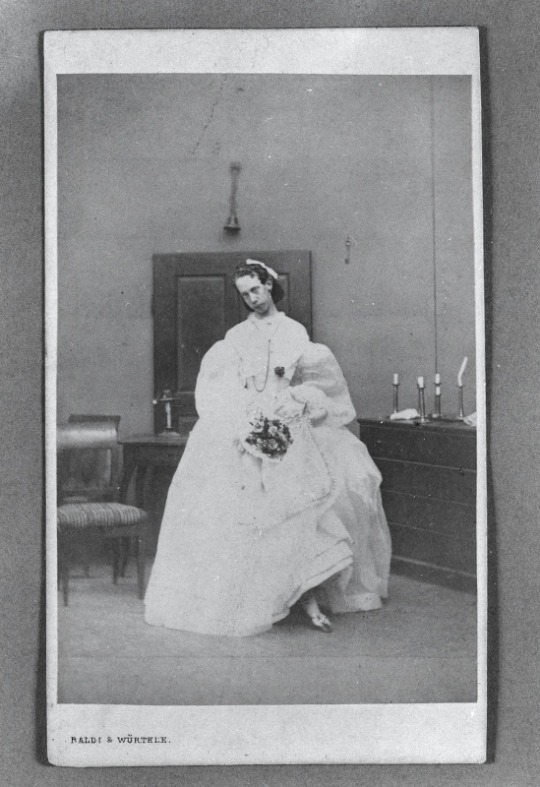
***gyengébbek kedvéért:

8 notes
·
View notes